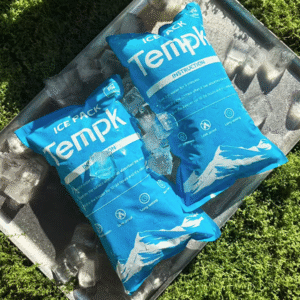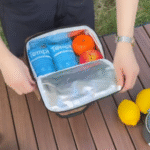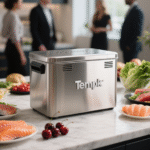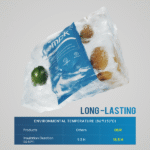A cold chain supply chain management system makes sure that perishable goods stay within their required temperature ranges from the moment they are produced to the moment they are used. It oversees storage, Verpackung, Transport, and real time monitoring, ensuring that food, Arzneimittel, and biologics arrive fresh, wirksam, und sicher. According to Tempk’s 2025 Führung, the global cold chain monitoring market is expected to rise from 35,03 Milliarden US-Dollar im Jahr 2024 to US$119.74 billion by 2030, reflecting the growing importance of comprehensive cold chain management. Parallel dazu, cloud based cold chain management platforms are forecast to increase from US$9.12 billion in 2024 to US$11.52 billion in 2025. With these shifts, companies must optimize their cold chain supply chain management to protect products, Abfall reduzieren, and meet strict regulations.

What makes cold chain supply chain management essential in 2025? Understand why integrated systems are critical for perishable products and regulatory compliance.
How do you build a robust cold chain management system? Explore the nine core elements required to maintain temperature integrity across storage, Verpackung, Transport, und Überwachung.
How do technologies like IoT and AI transform cold chain supply chain management? Learn how real time sensors, KI-Algorithmen, and blockchain improve efficiency and traceability.
Which sustainability practices enhance cold chain supply chain management? Find out how green logistics, renewable energy, and waste reduction improve performance and meet environmental goals.
What challenges and risks affect cold chain supply chain management? Identify stress points, Tarife, climate disruptions, and labor shortages—and discover strategies to build resilience.
What are the latest trends and innovations for 2025? Review market data, innovations like blockchain and cryogenic freezers, and emerging best practices.
Why is cold chain supply chain management essential in 2025?
Direkte Antwort: Cold chain supply chain management is essential because the volume of temperature sensitive goods is soaring, regulations are tightening, and consumers demand fresher products. A robust system protects product integrity, reduziert Abfall, and ensures compliance by coordinating storage, Transport, Verpackung, Überwachung, und Dokumentation. Ohne es, companies face spoilage, legal penalties, and lost trust.
Erweiterte Erklärung: Imagine shipping vaccines or fresh blueberries across continents. If the temperature deviates even a few degrees, they may lose potency or spoil. Research shows that 35 % of vaccines are compromised due to temperature mishandling, and some lose 20 % of their effectiveness after just one hour above +8 °C. Demand for biologics and mRNA vaccines intensifies these risks. In 2025, consumer habits (Z.B., ordering organic produce for next day delivery) and medical advances mean the stakes are higher. Regulations like the FDA’s Food Safety Modernization Act and the EU’s GDP require real time monitoring and documentation of temperature history. With climate driven disruptions and high volumes of perishable goods, businesses must build resilience into each stage of their cold chain supply chain management. Failing to do so can result in costly recalls, wasted products, und Reputationsschaden.
Core elements of a robust cold chain supply chain management system
An effective cold chain management system integrates nine interconnected components:
Technologie: Reusable thermal packaging, Phasenwechselmaterialien, and smart manufacturing methods provide consistent thermal stability and allow predictive performance.
Lagerung: Cold rooms, medical grade refrigerators, Isolierte Behälter, and advanced warehouses maintain required temperatures during storage.
Verpackung: Insulated envelopes, Behälter, and pallet systems protect goods during transit and handling.
Überwachung: Datenlogger, Temperaturanzeigen, Bluetooth-Sensoren, and telematics provide continuous visibility and alerts.
Transport: Refrigerated vehicles, Reefers, and IoT telematics ensure consistent temperatures during shipping and last mile delivery.
Customs Clearance: Accurate documentation and compliance prevent delays and spoilage.
Qualifikation: Thermal packaging qualification testing validates that materials and procedures meet Good Distribution Practice standards.
Product Management: Adequate storage facilities, trained personnel, and supplies secure products through their lifecycle.
Lieferung: Risikomanagement, experienced couriers, and proper handoffs reduce last mile excursions and damage.
| Element | Example Components | Zweck | Ihr Mitnehmen |
| Technologie | Reusable thermal packaging, Phasenwechselmaterialien | Provides thermal stability and predictive performance | Invest in validated technology to improve reliability and reusability |
| Lagerung | Cold rooms, medical refrigerators, Isolierte Behälter | Maintains temperature during warehousing | Use correct storage equipment and monitor capacity |
| Verpackung | Insulated envelopes, Behälter, pallet systems | Schützt Waren während des Transits | Match packaging to product and journey duration |
| Überwachung | Datenlogger, Bluetooth-Sensoren | Delivers real time visibility and alerts | Deploy continuous monitoring to catch excursions early |
| Transport | Kühlfahrzeuge, reefer containers, IoT telematics | Controls temperature during shipping | Plan routes and schedule maintenance to avoid breakdowns |
| Customs Clearance | Richtige Dokumentation, Einhaltung | Avoids delays and spoilage | Prepare paperwork and coordinate with brokers |
| Qualifikation | Thermal packaging qualification testing | Ensures packaging meets GDP standards | Perform routine validations and audits |
| Product Management | Adequate storage, trained personnel | Secures products through lifecycle | Train staff and maintain equipment inventory |
| Lieferung | Risikomanagement, experienced couriers | Reduces last mile excursions and damages | Optimize last mile operations and contingency plans |
Praktische Tipps und Ratschläge
Conduct a gap analysis: Map your supply chain to identify weak spots. Assess transit times, storage conditions, and handoffs. Address any missing elements or potential failure points.
Invest in monitoring hardware: Mit hardware accounting for 78.1 % of cold chain monitoring market revenue, ensure you deploy data loggers, RFID sensors, and telematics to gain real time visibility.
Build regulatory compliance into your processes: Adopt solutions meeting FDA and WHO guidelines. Maintain records of temperature compliance to satisfy auditors and avoid recalls.
Choose packaging carefully: Use thermal packaging appropriate for the product’s temperature range. Reusable packaging reduces waste and cost.
Verify temperature qualification: Perform qualification studies to confirm packaging performance under extreme conditions.
Fallbeispiel: A mid size pharmaceutical distributor integrated IoT sensors and predictive analytics into its regional network. The investment maintained stable temperatures during transit, reduced product waste by 30 %, and ensured compliance with FSMA documentation requirements.
Tatsächlicher Fall: A dairy exporter analyzed its cold chain using the nine element framework. It discovered customs clearance delays at certain ports were causing temperature excursions. By collaborating with brokers and pre checking documentation, the company reduced clearance time by 40 % and improved product quality at arrival.
How do technology and AI transform cold chain supply chain management?
Direkte Antwort: Technology and AI revolutionize cold chain supply chain management by providing real time visibility, prädiktive Analytik, and automation. IoT sensors monitor temperature and location continuously, AI algorithms optimise routes and anticipate disruptions, and blockchain ensures traceability. These tools improve reliability, Abfall reduzieren, and enable proactive decision making.
Erweiterte Erklärung: Traditional cold chain operations relied on manual checks and reactive responses. Heute, IoT devices such as Bluetooth sensors and RFID tags continuously monitor temperature, Luftfeuchtigkeit, und Lage. Cloud platforms aggregate this data, enabling supply chain managers to intervene when conditions deviate. AI algorithms analyze large datasets to optimize routes, prognostizierte Nachfrage, and predict maintenance needs. Zum Beispiel, AI can suggest alternative routes when extreme weather threatens to delay shipments, or identify patterns that indicate impending equipment failure. In 2025, cloud based cold chain management platforms are projected to grow 26 % jährlich, greifen US$11.52 billion, reflecting investments in real time monitoring and optimized logistics. Zusätzlich, blockchain technologies provide an immutable record of every handoff and environmental condition, boosting transparency and trust. Zusammen, these technologies enable a proactive approach to cold chain supply chain management, lowering the risk of spoilage and ensuring regulatory compliance.
AI route optimisation and IoT sensors
AI powered route optimization is a breakthrough for managing temperature sensitive goods. By combining real time traffic data, weather forecasts, and vehicle conditions, AI systems generate optimized routes that minimize transit time and reduce the risk of temperature excursions. Predictive analytics can also anticipate supply chain disruptions and suggest contingency routes.
IoT sensors and smart devices monitor temperature, Luftfeuchtigkeit, and location in real time. When sensors detect unsafe conditions, they automatically send alerts to supply chain managers via text or email. These devices often include GPS functionality, enabling end to end visibility and facilitating compliance with regulatory requirements. Sensors with AI capabilities can even predict equipment failures and schedule maintenance, reducing downtime and improving reliability.
| Technology Solution | Beschreibung | Vorteile | Bedeutung |
| IoT -Sensoren & Intelligente Verpackungen | Geräte, die die Temperatur überwachen, Luftfeuchtigkeit, und Lage; smart packaging integrates sensors into containers | Provide real time visibility, early warning of deviations, and compliance documentation | Essential for regulatory compliance and reducing spoilage |
| AI Route Optimisation | Algorithms analyze traffic, Wetter, and historical data to create efficient routes | Shortens delivery times, reduces fuel consumption, and minimizes temperature excursions | Supports cost savings and reliability |
| Prädiktive Analytik & Wartung | AI models identify patterns indicating equipment failure, enabling proactive maintenance | Prevents breakdowns, reduces downtime, and improves warehouse safety | Critical for continuous operations |
| Blockchain -Rückverfolgbarkeit | Distributed ledger records each step and environmental condition of shipments | Ensures transparency, reduces fraud, and simplifies audits | Builds trust among stakeholders |
| Cloud Based Platforms | Centralized systems that aggregate data, Bereitstellung von Dashboards, and integrate with AI | Enable remote monitoring, Analytik, and rapid decision making | Support scalability and collaboration |
Praktische Tipps und Ratschläge
Start with basic sensors: Even small businesses can begin with simple data loggers to track temperature and humidity. As budgets allow, upgrade to IoT sensors with GPS and connectivity.
Integrieren Sie Plattformen: Choose cloud based platforms that consolidate data from sensors, Fahrzeuge, und Lagerhäuser. Look for API integration with existing systems to avoid manual input.
Leverage AI gradually: Use AI to analyze historical data and optimize routes. Start with pilot routes and expand once results show improved efficiency.
Plan for blockchain: Consider implementing blockchain for high value or regulated products. Start by connecting with supply chain partners willing to adopt distributed ledger technology.
Fallbeispiel: Im Februar 2025, Elixia Inc. launched Elixia Connect, an AI driven cold chain logistics marketplace that matches shippers with temperature controlled carriers and provides real time tracking and route optimization. This innovation highlights how AI and marketplaces can streamline cold chain supply chain management.
Tatsächlicher Fall: A pharmaceutical company deployed AI enabled predictive analytics on its cold chain platform. By analyzing sensor data and weather forecasts, the system predicted potential temperature deviations and recommended alternative routes. Infolge, the company improved on time delivery by 15 % and reduced product loss.
Which sustainability practices improve cold chain supply chain management?
Direkte Antwort: Sustainability practices such as green logistics, renewable energy adoption, low GWP refrigerants, and waste reduction enhance cold chain supply chain management. These initiatives lower energy costs, meet regulatory requirements, and build brand reputation while maintaining product integrity.
Erweiterte Erklärung: Cold chain operations are inherently energy intensive. Refrigeration and transportation consume significant power, and conventional refrigerants often have high global warming potential. In 2025, sustainability is no longer optional; it is a requirement. Trends include adopting renewable energy, electrifying transport fleets, optimizing facility design, and reducing food waste. Green logistics aims to cut carbon emissions through efficient route planning, load consolidation, and use of biofuels or electric vehicles. Companies also invest in solar powered warehouses and on site renewable energy. Zum Beispiel, Emergent Cold LatAm’s new facilities in Latin America are EDGE Advanced certified and even include the world’s first EDGE Zero Carbon plant in Chile, showcasing the shift towards resource efficient solutions. Low GWP refrigerants and the Move to –15 °C initiative promote energy efficient refrigeration technologies and sustainable practices. Reducing food loss and waste—currently 1 billion tons annually—is critical for both sustainability and efficiency. Durch Übernahme dieser Praktiken, companies improve resilience, meet customer expectations, and contribute to global environmental goals.
Green logistics and climate resilience
Green logistics involves designing supply chains that minimize environmental impact while maintaining efficiency. Key strategies include:
Renewable energy: Solar and wind energy power refrigeration systems and warehouses. Solar powered cold storage units reduce energy costs and support rural areas with inconsistent grids. Zum Beispiel, commercial solar rates in the U.S. range from 3.2 Zu 15.5 Cent pro kWh, offering significant savings compared to conventional electricity prices.
Electrification and alternative fuels: Electric refrigerated trucks and biofuel powered fleets reduce emissions and operating costs.
Low GWP refrigerants: Der Move to –15 °C coalition promotes energy efficient refrigeration technologies and sustainable practices.
Built to suit solutions: Customized facilities match operational needs and incorporate energy saving measures, optimizing efficiency and reducing waste.
Climate resilience: Investing in resilient infrastructure mitigates risks posed by extreme weather events like floods or droughts.
Food waste reduction: Enhancing cold chain management to reduce food loss helps decrease greenhouse gas emissions and preserves resources.
| Sustainability Practice | Beschreibung | Vorteile |
| Erneuerbare Energie | Use of solar, wind, or biomass to power refrigeration and warehouse operations | Reduces energy costs and carbon footprint; increases reliability in regions with unstable grids |
| Low GWP Refrigerants & Move to –15 °C | Adoption of refrigerants with low global warming potential and standardization at –15 °C | Improves energy efficiency and meets environmental regulations |
| Electric or Biofuel Fleets | Transition from diesel to electric or biofuel trucks | Reduces emissions, operating costs, and noise pollution |
| Built to Suit & Edge Certified Facilities | Custom-designed warehouses optimized for efficiency; Edge certification ensures sustainability | Saves energy, reduziert Abfall, and supports climate goals |
| Food Waste Reduction | Robust cold chain management prevents spoilage and extends shelf life | Decreases environmental impact and improves profitability |
Praktische Tipps und Ratschläge
Assess energy usage: Conduct an energy audit of your cold chain operations. Identify opportunities to install solar panels, wind turbines, or energy recovery systems.
Adopt low GWP refrigerants: Evaluate current refrigeration systems and plan transitions to low GWP refrigerants. Check compatibility with existing equipment.
Invest in electric vehicles: Start by electrifying last mile delivery or using hybrid refrigeration units. Seek government incentives for sustainable fleets.
Optimize facility design: When building or refurbishing warehouses, integrate energy-efficient materials, Isolierung, and automation to reduce energy consumption.
Implement waste reduction strategies: Monitor and forecast demand to avoid overproduction. Use inventory rotation strategies to reduce expired stock.
Fallbeispiel: Emergent Cold LatAm has built new facilities in Latin America that are EDGE Advanced certified und schließen die world’s first EDGE Zero Carbon plant. These facilities use renewable energy, optimize energy management, and demonstrate climate leadership.
Tatsächlicher Fall: A food distribution company implemented a waste reduction initiative that used predictive analytics to align procurement with demand. By optimizing inventory and using improved cold storage, the firm cut food waste by 25 % and reduced its carbon footprint.
What challenges and risks affect cold chain supply chain management in 2025?
Direkte Antwort: The main challenges include supply chain stress points due to rising volumes of temperature sensitive shipments, geopolitical disruptions and tariffs, extreme weather events, labor shortages, and the high cost of technological upgrades. Jedoch, strategische Planung, resilient infrastructure, and adoption of digital solutions can mitigate these risks.
Erweiterte Erklärung: As the cold chain industry grows, stress points emerge across the supply chain. Research highlights that North America holds more than 33 % of global cold chain monitoring revenue, while Asia Pacific is the fastest growing region. Growing volumes of sensitive shipments create bottlenecks, requiring investment in scalable monitoring and logistics systems. Hardware dominates the market, Repräsentation 78.1 % der Einnahmen, highlighting the reliance on physical devices like sensors and telematics. Food and beverage applications account for over 77 % of market share, while pharmaceuticals are the fastest growing segment due to vaccine distribution. Zusätzlich, tariffs on IoT sensors and cloud storage hardware threaten to inflate costs and slow adoption of cloud based platforms. Climate change causes extreme weather events—floods, droughts, and heatwaves—that disrupt logistics and require resilient infrastructure. Labor shortages and the high cost of adopting new technologies also present significant barriers.
Supply chain resilience and risk mitigation
Geopolitical disruptions and tariffs: Trade tensions can raise costs for sensors and cloud hardware, leading to data latency and spoilage risks. Schadensbegrenzung: diversify suppliers, source domestically where possible, and invest in local manufacturing.
Climate change: Extreme weather events disrupt transportation and storage. Schadensbegrenzung: invest in resilient infrastructure, diversify routes, and maintain safety stock.
Labor shortages: The logistics industry faces ongoing labor shortages. Schadensbegrenzung: adopt automation and robotics to supplement workforce and reduce reliance on manual labor.
Technology costs: High costs hinder small businesses from adopting IoT and AI. Schadensbegrenzung: start with scalable, modular solutions and consider using cloud based platforms or subscription models.
Data security and privacy: Increased connectivity raises cybersecurity risks. Schadensbegrenzung: implement strong encryption, access controls, and compliance with data protection regulations.
| Herausforderung | Beweis | Suggested Solution |
| Rising shipment volumes | Sensitivity to temperature leads to high volumes and stress points; Nordamerika hält >33 % revenue, Asia Pacific grows fastest | Invest in scalable monitoring systems and robust logistics planning |
| Geopolitische Störungen & Tarife | Tariffs on IoT sensors may inflate costs and cause data latency | Lieferanten diversifizieren, seek local production, and adjust budgets |
| Climate change & extreme weather | Floods and droughts disrupt logistics | Build resilient infrastructure, maintain safety stock, diversify routes |
| Labor shortages | Growing industry strains workforce | Invest in automation, Robotik, and training programs |
| High cost of technology adoption | Hardware dominates 78.1 % Marktanteil, raising barriers | Implement modular IoT solutions, choose subscription or cloud based services |
| Datensicherheit & Privatsphäre | Increased connectivity exposes vulnerabilities | Use encryption, Blockchain, and regular cybersecurity audits |
Praktische Tipps und Ratschläge
Entwickeln Sie Notfallpläne: Identify potential disruptions—tariffs, extreme weather, port closures—and create alternative routes and suppliers.
Collaborate across the supply chain: Share data with suppliers and customers to improve forecasting and risk management.
Optimize inventory: Maintain strategic stock levels to buffer against delays and disruptions.
Invest in employee training: Educate staff on new technologies and protocols to ensure effective adoption.
Fallbeispiel: When tariffs threatened to increase costs for sensor imports, a cold chain logistics provider partnered with local manufacturers to source sensors domestically. This strategy reduced costs, improved supply reliability, and protected data integrity.
Tatsächlicher Fall: A seafood exporter faced frequent delays due to climate related flooding. By diversifying transport routes, investing in flood resistant storage facilities, and using AI to predict weather related disruptions, the company maintained on time deliveries and prevented spoilage.
2025 developments and trends for cold chain supply chain management
Die Kühlkettenbranche entwickelt sich rasant weiter. Here are key developments and innovations shaping cold chain supply chain management in 2025:
Latest progress overview
Explosive growth in cold chain monitoring and cloud platforms: The global cold chain monitoring market will expand from 35,03 Milliarden US-Dollar im Jahr 2024 to US$119.74 billion by 2030. Gleichzeitig, the cloud based cold chain management market will grow from US$9.12 billion in 2024 to US$11.52 billion in 2025, mit einer CAGR von 26 %, and reach US$28.87 billion by 2029. This growth highlights adoption of real time monitoring, Ai, and blockchain technologies.
AI Driven Marketplaces and Predictive Analytics: Unternehmen mögen Elixia have launched AI based cold chain logistics marketplaces, connecting shippers with carriers while providing real time tracking and route optimization. Predictive analytics platforms (Z.B., ELPRO’s elproPREDICT) offer real time alerts and cost optimization.
Nachhaltigkeit & Erneuerbare Energie: Trends include solar powered cold storage units and renewable energy integration. Solar power reduces energy costs and ensures reliable refrigeration in regions with unstable grids. Built to suit facilities are designed to meet sustainability and efficiency standards.
Edge & Zero Carbon Facilities: Emergent Cold LatAm built the world’s first EDGE Zero Carbon plant in Chile, showcasing carbon neutral cold storage.
Green Logistics & Move to –15 °C Initiative: Companies adopt low GWP refrigerants, energy efficient refrigeration, and implement the Move to –15 °C coalition’s guidelines.
Blockchain & Rückverfolgbarkeit: Blockchain ensures end to end visibility and tamper proof records, which are essential for pharmaceutical cold chains. The technology helps track shipments and maintain compliance.
Solar, IoT & AI for Last Mile Delivery: Solar powered units and IoT enabled devices support remote areas. AI improves route optimization and predictive maintenance.
Portable Cryogenic Freezers: Innovative cryogenic freezers maintain ultra low temperatures for biologics and cell therapies.
Regional Growth Patterns: Asia Pacific is the fastest growing region due to consumption growth and investment in infrastructure. North America remains the largest revenue generator but faces challenges from labour shortages and tariff barriers.
Neueste Fortschritte auf einen Blick
Investments & Mergers: Companies such as Cold Chain Technologies acquired Global Cold Chain Solutions to expand global reach. Mergers and expansions continue to increase capacity and improve service offerings.
Built to Suit & Outsourcing: High infrastructure and maintenance costs push companies to outsource cold storage operations and use customized facilities designed for their needs.
Resilience & Climate Adaptation: Operators invest in resilient infrastructure to handle climate events (Z.B., floods, droughts) and maintain supply chain continuity.
Markteinsichten: Studies from Precedence Research, Fortune Business Insights, and IMARC show strong double digit growth for the cold chain logistics market. Precedence Research projects the market size to increase from 436,3 Milliarden US-Dollar im Jahr 2025 auf 1.359,78 Milliarden US-Dollar 2034. Spherical Insights forecasts growth from US$384.51 billion in 2024 to US$1.535 trillion by 2035. Fortune Business Insights and IMARC report similar growth trajectories for 2023–2033. These figures underscore the expanding importance of cold chain supply chain management.
Market and innovation insights
| Development | Beweis | Praktische Implikationen |
| Überwachung & Cloud Growth | Cold chain monitoring market to reach US$119.74 billion by 2030; cloud market to reach US$28.87 billion by 2029 | Demand for real time data drives adoption of sensors, Ai, and cloud platforms |
| AI Driven Platforms | Elixia Connect provides AI powered logistics marketplace | Streamlines matching of shippers and carriers; enables route optimization |
| Nachhaltigkeit & Zero Carbon | Edge Advanced and Zero Carbon facilities in Latin America | Demonstrate commitment to sustainability; lower carbon footprint |
| Blockchain | Blockchain provides tamper proof traceability | Enhances transparency, meets regulatory requirements |
| Portable Cryogenic Freezers | Cryogenic freezers maintain –80 °C to –150 °C | Enables transport of cell therapies and biologics with ultra cold requirements |
| Regional Growth | Asia Pacific fastest growth | Requires investment in infrastructure and adoption of digital solutions |
Praktische Tipps und Ratschläge
Monitor emerging technologies: Stay informed about AI, Blockchain, and cryogenic innovations. Pilot new technologies in controlled settings before scaling.
Plan for regulatory changes: Anticipate evolving regulations for refrigerants, data privacy, und Pharmazeutika. Collaborate with industry associations to remain compliant.
Embrace sustainability early: Early adopters of renewable energy and low GWP technologies gain competitive advantage and align with global climate goals.
Strengthen regional strategies: Expand into high growth regions like Asia Pacific, but tailor solutions to local infrastructure and regulatory environments.
Tatsächlicher Fall: In 2025, Cold Chain Technologies acquired Global Cold Chain Solutions, expanding its global reach and expertise across industries like pharmaceuticals and biotechnology. This highlights industry consolidation and the importance of acquiring specialized capabilities.
Häufig gestellte Fragen
Frage 1: What is cold chain supply chain management?
Cold chain supply chain management is the coordinated control of temperature sensitive products throughout the supply chain. It involves technology, Lagerung, Verpackung, Überwachung, Transport, Zollabfertigung, qualification, product management, und Lieferung. The objective is to maintain product quality, Sicherheit, und Compliance.
Frage 2: How does a robust cold chain management system work?
A robust system integrates nine core elements: reusable thermal packaging, cold storage facilities, Isolierte Verpackung, kontinuierliche Überwachung, Kühltransport, accurate customs clearance, thermal packaging qualification, trained personnel, and risk managed delivery. These components work together to maintain temperature integrity and reduce risks.
Frage 3: Why is real time monitoring important in cold chain supply chain management?
Real time monitoring provides continuous visibility into temperature, Luftfeuchtigkeit, und Lage. If conditions deviate, managers receive alerts and can intervene before product quality is compromised. Continuous monitoring is also mandatory under many regulatory frameworks.
Frage 4: How does AI optimize cold chain logistics?
AI analyzes data from sensors, weather forecasts, and traffic to optimize routes, predict equipment failures, and forecast demand. This reduces transit time, improves reliability, and lowers costs.
Frage 5: What sustainability practices should companies adopt?
Companies should invest in renewable energy, low GWP refrigerants, electric or biofuel fleets, energy efficient facility design, and strategies to reduce food waste. These practices lower environmental impact and align with regulatory requirements.
Frage 6: What are the biggest challenges facing cold chain supply chain management?
Challenges include rising shipment volumes, tariffs on IoT devices, climate driven disruptions, labor shortages, high technology costs, and data security. Companies can mitigate these risks through contingency planning, Automatisierung, diversified sourcing, and strong cybersecurity.
Zusammenfassung und Empfehlungen
Key Takeaways: Cold chain supply chain management is the backbone of delivering fresh foods, Arzneimittel, and biologics to consumers and patients. The industry is growing rapidly, with monitoring and cloud based management markets projected to exceed US$119 billion and US$28 billion, jeweils, von 2030. An effective system integrates nine elements—technology, Lagerung, Verpackung, Überwachung, Transport, Zollabfertigung, qualification, product management, und Lieferung. Technologies like IoT, Ai, prädiktive Analytik, Blockchain, and cloud platforms provide real time visibility and automation. Sustainability practices, such as renewable energy, low GWP refrigerants, and waste reduction, are imperative. The industry faces challenges from rising volumes, Tarife, climate events, labor shortages, and cybersecurity risks. Jedoch, strategische Planung, innovative technologies, and collaboration across the supply chain can mitigate these risks and build resilience.
Umsetzbarer Rat: Evaluate your existing cold chain management against the nine elements. Identify gaps and prioritize investments in monitoring hardware, prädiktive Analytik, and renewable energy. Design contingency plans for tariffs, climate disruptions, and labor shortages. Collaborate with partners to improve data sharing and adopt blockchain for traceability. Invest in employee training and encourage innovation. Endlich, explore local incentives for solar energy and low GWP refrigerants to reduce costs and meet sustainability goals.
Über Tempk
Tempk ist spezialisiert cold chain supply chain management Lösungen, offering integrated services across storage, Verpackung, Transport, Überwachung, und regulatorische Einhaltung. We operate advanced warehouses and a fleet of refrigerated vehicles equipped with IoT sensors and AI powered route optimization. Our solutions maintain temperature integrity for pharmaceuticals, Biologika, und Lebensmittelprodukte, Gewährleistung der Einhaltung der FDA, EU, und WHO-Richtlinien. We invest in renewable energy and low GWP refrigerants to deliver sustainable logistics. Our team of experts works closely with clients to design custom solutions that balance efficiency, kosten, und Umweltverantwortung.
Aufruf zum Handeln: Ready to strengthen your cold chain supply chain management? Contact Tempk today for a customized assessment and discover how our solutions can protect your products, Abfall reduzieren, und unterstützen Sie Ihre Nachhaltigkeitsziele.






















